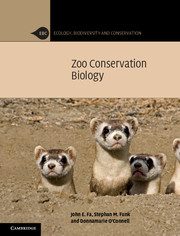Book contents
- Frontmatter
- Contents
- Foreword
- Preface
- Acknowledgements
- 1 Biodiversity and zoo conservation biology
- 2 Protecting species and habitats
- 3 Zoos in focus – public exhibition or conservation
- 4 Keeping animals in captivity
- 5 Viable captive populations – the numbers game
- 6 Captive breeding and zoos
- 7 Returning animals to the wild
- 8 Educating the public
- 9 Turning zoos into conservation centres
- Appendix 1 Commonly used abbreviations
- Appendix 2 Scientific names of species mentioned in the text
- Appendix 3 Inbreeding
- Appendix 4 Population sizes – definitions and implications
- Appendix 5 Captive breeding and genetics – definitions
- References
- Index
- Plate section
Preface
Published online by Cambridge University Press: 05 August 2012
- Frontmatter
- Contents
- Foreword
- Preface
- Acknowledgements
- 1 Biodiversity and zoo conservation biology
- 2 Protecting species and habitats
- 3 Zoos in focus – public exhibition or conservation
- 4 Keeping animals in captivity
- 5 Viable captive populations – the numbers game
- 6 Captive breeding and zoos
- 7 Returning animals to the wild
- 8 Educating the public
- 9 Turning zoos into conservation centres
- Appendix 1 Commonly used abbreviations
- Appendix 2 Scientific names of species mentioned in the text
- Appendix 3 Inbreeding
- Appendix 4 Population sizes – definitions and implications
- Appendix 5 Captive breeding and genetics – definitions
- References
- Index
- Plate section
Summary
Zoos are becoming increasingly important centres, not just for exhibition and recreation, but also for promoting and actively engaging in animal conservation. Emphasis is now placed on educating the visiting public, alongside entertaining them. However, zoos continue to play an important role in ex-situ breeding and reintroduction of endangered species.
The efficacy of zoos as institutions capable of maintaining healthy individuals and populations has undoubtedly grown in recent years, as a result of the development of scientifically based techniques. There is a wealth of information now available on zoo management, animal husbandry techniques, captive propagation of species as genetically and demographically viable populations, as well as on the importance of zoos in biodiversity conservation. Some of this knowledge is contained in specialised publications, such as the journal Zoo Biology, or the International Zoo Yearbook but the literature is dispersed and there are no dedicated texts currently available. No book, however, has directly focussed on what we describe as ‘zoo conservation biology’. Zoo conservation biology, distinct from zoo biology which is much more to do with the ‘how to’ of breeding, behaviour and maintenance of animal species in captivity, is a discipline which studies how zoos can best contribute to biodiversity conservation. Alongside books and literature that support the technical aspects of captive animal management, zoo conservation biology pays more attention to achieving clarity on how best science can be applied within zoos to achieve species recovery and environmental awareness at a global scale. Thus, the object of this book is to provide an up-to-date review of the potential of zoos to actively support the conservation of biodiversity. It is an introduction to conservation biology from within zoos as it relates to the management of animals in captivity and how zoos can function as well-coordinated educational and commercial establishments.
- Type
- Chapter
- Information
- Zoo Conservation Biology , pp. xiPublisher: Cambridge University PressPrint publication year: 2011

